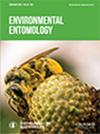Diurnal predators in dim light: the ability of mantids to prey for supper
IF 1.8
3区 农林科学
Q2 ENTOMOLOGY
引用次数: 0
Abstract
Many insects rely heavily on visual cues in foraging and other life activities. Mantids are insect predators that usually ambush prey. The sophisticated visual system of mantids allows them to spot, track, and strike at prey with high accuracy. Mantids are categorized as diurnal animals in most cases, while our field observations suggested that they were active in foraging both day and night. Therefore, we hypothesize that predation in dim light is possible for mantids, while mantids are unable to capture prey in complete darkness. In this study, we experimentally examined whether different light conditions could affect the predation success and efficiency of mantid nymphs and adults, Hierodula chinensis Werner (Mantodea: Mantidae), through behavioral observations. Individual mantids were placed in individual chambers in complete darkness, simulated moonlight (0.1 lux), or simulated dusk (50 lux) conditions and were allowed to forage for prey items for 10 min. Our observations showed no evidence that H. chinensis could capture any prey in complete deprivation of light. The proportion of nymphs with successful predation in simulated moonlight was 50% higher than that in complete darkness and 45.83% lower than that in simulated dusk. The proportion of adults with successful predation in simulated moonlight was 42.11% higher than that in complete darkness and 57.89% lower than that in simulated dusk. Overall, the results provide new insights into the behavioral ecology of diurnal predators at night, with potential association with moonlight, starlight, and light pollution.昏暗光线下的昼行捕食者:螳螂捕食的能力
许多昆虫在觅食和其他生命活动中都非常依赖视觉线索。螳螂是昆虫捕食者,通常会伏击猎物。螳螂复杂的视觉系统使它们能够准确地发现、追踪和攻击猎物。螳螂在大多数情况下被归类为昼行性动物,而我们的实地观察表明,螳螂昼夜都在积极觅食。因此,我们假设螳螂可以在微弱的光线下捕食,而无法在完全黑暗的环境中捕获猎物。在这项研究中,我们通过行为观察实验研究了不同的光照条件是否会影响螳螂若虫和成虫(螳螂科:Hierodula chinensis Werner)的捕食成功率和捕食效率。将单独的螳螂置于完全黑暗、模拟月光(0.1勒克斯)或模拟黄昏(50勒克斯)条件下的单独小室中,让其觅食10分钟。我们的观察结果表明,没有证据表明在完全无光的条件下,姬蛙能捕捉到任何猎物。在模拟月光条件下,成功捕食的若虫比例比完全黑暗条件下高50%,比模拟黄昏条件下低45.83%。成虫在模拟月光下捕食成功的比例比完全黑暗条件下高42.11%,比模拟黄昏条件下低57.89%。总之,这些结果为夜间捕食者的行为生态学提供了新的见解,可能与月光、星光和光污染有关。
本文章由计算机程序翻译,如有差异,请以英文原文为准。
求助全文
约1分钟内获得全文
求助全文
来源期刊

Environmental Entomology
生物-昆虫学
CiteScore
3.90
自引率
5.90%
发文量
97
审稿时长
3-8 weeks
期刊介绍:
Environmental Entomology is published bimonthly in February, April, June, August, October, and December. The journal publishes reports on the interaction of insects with the biological, chemical, and physical aspects of their environment. In addition to research papers, Environmental Entomology publishes Reviews, interpretive articles in a Forum section, and Letters to the Editor.
 求助内容:
求助内容: 应助结果提醒方式:
应助结果提醒方式:


